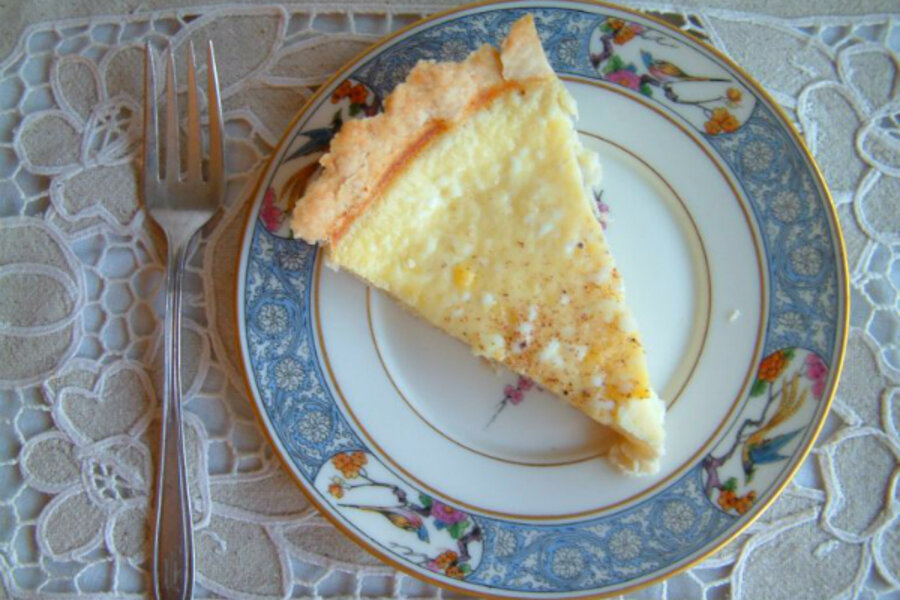Pi Day: Celebrate with a vintage custard pie
Loading...
Baking a pie for Pi Day (March 14, aka 3.14) may seem like a daunting task. But an easy recipe to tackle would be this simple Victorian custard pie from the late 1800s. With its short list of ingredients, not much can go wrong. I tested it last fall for the Mary Baker Eddy Library, which sponsored a month-long look at 19th-century foodways. (Mary Baker Eddy was the founder of The Christian Science Monitor.)
The first thing I noticed was how few eggs and little sugar are used in this recipe. Most contemporary custard pie recipes call for 3 to 4 eggs and at least 3/4 cups of sugar, as opposed to the old-timey 3 tablespoons in this recipe from Fannie Farmer’s “The Boston Cooking-School Cookbook.” This could be for two reasons: (1) sugar was an expensive commodity in the late 1800s and (2) the American diet was much more bland than it is today.
I doubt the taste buds of our Victorian-era ancestors could tolerate our modern sugar-based diet!
The other wording I stumbled over in this recipe was “paste,” this of course meant the pie shell. And in Fannie Farmer’s cookbook there was no actual recipe for the pie shell. I can only assume that the cooking school took for granted that most home cooks knew how to mix and roll out a pie shell.
I do not, at least not by heart.
My preference, of course, is to buy a premade pie shell because it’s so easy and takes no time. But for the sake of recreating the Victorian experience, I persisted to rollout my own dough. If you are a novice pie dough maker like me, be sure to mix and refrigerate your dough before preparing the filling.
The recipe also does not indicate how much to preheat the oven, nor how long the custard pie should bake. It simply says “bake in a quick oven at first.” So I preheated the oven to 400 degrees F., and then reduced it to 350 degrees F., after the rim had set, as the recipe instructs.
I have no idea how long I left it in the oven, since the instructions didn’t specify. I simply took it out when it looked done and set. Usually when I’m cooking I set my timer on the microwave and multi-task with other chores, checking my e-mail, or watching TV. That is one thing you’ll notice about late 19th-century recipes, they take for granted that the cook of the house was probably in the kitchen all day, tending to the wood or coal stove, peeling vegetables for the next meal, or planning dishes for the reminder of the week.
A custard pie may have been a quick finish to a more elaborate meal in an 19th-century household, an easy aside in a whirl of cooking and baking. In my modern kitchen, it was the main event.
The finished product was delicate and not very sweet, and I could see how it would make an appropriate dessert for a heavy meal like a New England Boiled Dinner. In fact, I found it to be so bland it was like a dressed-down quiche. I enjoyed a slice for breakfast several days in a row.
After all, pie for breakfast has long been a tradition in the Yankee kitchen, according to “The American Heritage Cookbook”: ”The custom of eating apple pie for breakfast, at which lesser men have quaked and blanched, has seemed natural, inevitable, and pleasurable to New Englanders. ‘What is pie for?’ Emerson exclaimed, and the matter was settled.”
Custard Pie
From the “Boston Cooking-School Cookbook“
2 eggs
3 tablespoons sugar
1/8 teaspoon salt
1-1/2 cups milk
1/4 teaspoon salt
Few gratings nutmeg
Beat eggs slightly, add sugar, milk. Line plate with paste*, and build up a fluted rim. Strain in the mixture and sprinkle with a few gratings of nutmeg. Bake in a quick at oven at first to set the rim, decrease the heat afterwards, as eggs and milk combination need to be cooked at low temperature.
*Pastry for pie crust
From “American Heritage Cookbook”
1 cup all-purpose flour
1/2 teaspoon salt
1/3 cup shortening
2 to 3 tablespoons ice water
Sift flour and salt together in a bowl. Cut in shortening with a pastry blender or two knives until mixture looks mealy. Sprinkle water over mixture (the less water you use, the better your pastry). Mix lightly with a fork, then work the pastry with your hands until it can be formed into a ball. Chill thoroughly. Using light strokes, roll out on a floured board. Start at the center and roll toward the edge. When dough is about 1/8 inch thick, line a 9-inch pie pan, pressing pastry to bottom and sides. Refrigerate while you prepare the filling.
This post was part of the First Saturday program at The Mary Baker Eddy Library, which is sponsored a month-long look at 19th-century foodways.






